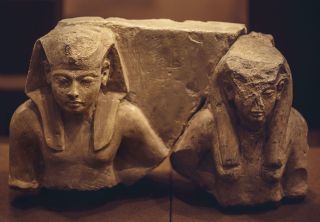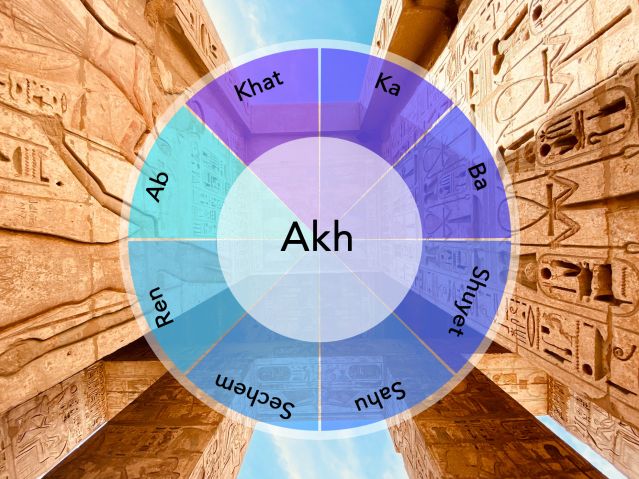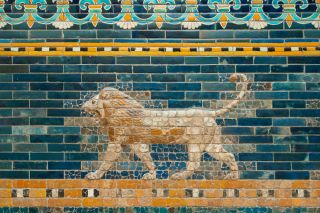Wisdom
Ancient Concepts of the Mind, Brain (and Soul)
How did ancient cultures view the mind and brain? A look at three civilizations.
Posted June 28, 2023 Reviewed by Gary Drevitch
Key points
- Our concept of the mind the way it is studied in psychology is a modern notion.
- Many ancient cultures saw the heart as the seat of thought, emotion, and volition.
- Neuroscience is also a modern concept but neurology has been around for millennia.
- Many ancient cultures had a profound understanding of brain lesions and other neurological disorders.

The German psychologist Hermann Ebbinghaus wrote in 1908 that “Psychology has a long past, but only a short history.” Humans have been pondering, debating, and discussing the mind for millennia but the formal study of the mind — the academic and scientific discipline of psychology — is still very young. Neurology, the medical field that deals with the nervous system, has a much longer history. Here is a brief overview of how ancient cultures in three areas viewed the mind, the brain, and the soul.
Ancient Egypt
The oldest known medical texts that still exist come from ancient Egypt and are estimated to be between 4,500 to 5,000 years old (Frey, 1985). Among them is the Edwin Smith Surgical Papyrus, which has the oldest known mention of the word “brain” using hieroglyphs (Minagar et al., 2003). The ancient papyrus scroll is believed to be a 3,000-year-old copy of a much older text (named after the American antiquities dealer who bought it in 1862 (van Middendorp et al., 2010)) and its insights into neurology are astounding.
The papyrus shows a detailed understanding of brain anatomy. For example, case six describes the folds of the walnut-shaped cortex (the gyri and sulci) that were described “like the corrugations that form molten copper”; the membranes covering the brain (meninges); and even the cerebrospinal fluid (Wilkins, 1964). Other parts highlight that ancient Egyptians were aware of the left brain controlling the right side of the body and vice-versa. They knew that control extends from the brain through the spinal cord and that injury to the brain or the spinal cord can result in paralysis (Chudler, 2023; van Middendorp et al., 2010; Wilkins, 1964). There is even a description of aphasia—the loss of speech—due to brain injury (Minagar et al., 2003). Overall, ancient Egyptian physicians understood several key aspects of the brain and neuroscience.

While ancient Egyptians had a profound understanding of neurology, their view of the mind was very different from that of modern psychology. They had a polypsychic view, believing that the self consists of many constituent parts. While the number of parts varied over time, Egyptologists have found evidence for eight distinct parts that collectively combined into something similar to what would we call a soul, which they termed Akh (Mark, 2017).
Ancient Egyptians had a complex view of how the body and the soul interact. The physical body (Khat) was seen as part of the soul and even after death, the soul would still need to eat, drink, and need protection—hence the elaborate burial gifts that frequently included food (Mark, 2017). In fact, they believed that the soul still needed a physical body after death, which is why important and wealthy Egyptians were mummified (Smithsonian, n.d.). Paradoxically, the brain was not seen as important, despite their detailed understanding of neurology, and was discarded during mummification. Some other organs were preserved separately and only the heart was put back in its place after treatment as it was believed to be the centre of a person’s being and intelligence (Smithsonian, n.d.).

Ancient Mesopotamia
Ancient Mesopotamia includes Sumerian, Akkadian, Babylonian, and Assyrian cultures, which had varied views and beliefs (Choksi, 2014). Evidence for how those cultures viewed the mind and the brain is scarce and most of what we know has been pieced together from different sources across time and genres (Choksi, 2014). Just as in ancient Egypt, ancient Mesopotamians saw humans as a pluralistic unity of multiple components (Steinert, 2012). Words used for a personal self (like the English “I” or “me”) derived from body parts but were used to express things including personal responsibility or agency (Steinert, 2012). There is evidence that Mesopotamians viewed the physical body as the centre of the entire self without any clear distinction between the mind and body (Steinert, 2012). However, there is also evidence that Mesopotamians believed in an afterlife where people continue to exist in a spirit-form called etemmu (Choksi, 2014).

Unlike the neighbouring Egyptians, Mesopotamians did not use mummification and had only a very rudimentary understanding of anatomy: There is no evidence of any detailed knowledge of the brain or spinal cord (Karim & Amin, 2018). The heart was seen as the centre of emotion and thinking despite physicians knowing that lesions to the brain could result in paralysis and aphasia, and being aware of strokes and their possible effects (Karim & Amin, 2018). In both Egypt and Mesopotamia, it seems that medical understanding was distinct from the cultural and religious view of the self, the mind/soul, and the body.
Ancient China
Ancient Chinese thought did not have a clear distinction between the mind and the body but saw humans more as holistic beings with the heart seen as the centre of thinking and reasoning (Yu, 2007). This view was expressed metaphorically: “Just as the emperor is the ruler of the country, so the heart is the ruler of the body” (Yu, 2007). But as Slingerland (2013) points out, this view of a strong mind-body holism may be a misinterpretation: Chinese literature makes a clear distinction between the heart and the body as well as the heart and other organs, which are explicitly described as subservient to the heart (or mind) because the heart has unique and qualitatively different powers (Slingerland, 2013). A second line of evidence for this comes from the strong belief in a spiritual world and an afterlife that is different from the physical world (Slingerland, 2013). In Confucian tradition, the mind (or heart) is what makes us truly human and includes empathy, shame, respect, and moral discernment (Chen, 2016). Mencius, an early Confucian scholar, defines the mind by its capacity for reason and righteousness, with a mental substance that is distinct from the body (Chen, 2016).

Ancient Chinese medicine made significant contributions to neuropharmacology and was among the first to identify neurological diseases and find pharmacological compounds that impact neural functioning, including marijuana and opioids (Chu, 2009; Learn, 2016). However, the nervous system itself was largely ignored and understanding of the brain or spinal cord was minimal (Chu, 2009). In fact, the brain was viewed as a reservoir for bone marrow and neurological diseases were attributed to insufficient bone marrow or other imbalances rather than to the brain itself (Chu, 2009).
Conclusion
The mind, as we conceive it today and the way it is studied in psychology, is a relatively recent concept. Ancient cultures mostly saw the heart as the seat of thought, emotion, and volition. Neurology has a long history and some ancient civilizations had a profound understanding of the brain and neurological pathologies. Others, however, did not pay much attention to the nervous system at all. On the whole, traces of current psychology and neuroscience can be found in ancient civilizations but they are merely traces; our view of both the mind and the brain has shifted dramatically since ancient times.
References
Choksi, M. (2014). Ancient Mesopotamian beliefs in the afterlife World History Encyclopedia. https://www.worldhistory.org/article/701/ancient-mesopotamian-beliefs-in-the-afterlife/
Chen, X. (2016). The problem of mind in Confucianism. Asian Philosophy, 26(2), 1-16. http://dx.doi.org/10.1080/09552367.2016.1165790
Chu, N. S. (2009). Neurology and traditional Chinese medicine. Handbook of Clinical Neurology, 95, 755-767. https://doi.org/10.1016/S0072-9752(08)02146-5
Chudler, E. H. (2023). The Edwin Smith surgical papyrus. https://faculty.washington.edu/chudler/papy.html
Frey, E. F. (1985). The earliest medical texts. Clio Med, 20(1-4):79-90.
Karim, S. K., & Amin, O. S. M. (2018). Stroke in ancient Mesopotamia. Medical Archives, 72(6), 449-452. https://doi.org/10.5455%2Fmedarh.2018.72.449-452
Learn, J. R. (2016). Drilling deep: How ancient Chinese surgeons opened skulls and minds. Smithsonian. https://www.smithsonianmag.com/science-nature/how-ancient-chinese-surgeons-opened-skulls-and-minds-180961286/
Mark, J. J. (2017). The soul in ancient Egypt. World History Encyclopedia. https://www.worldhistory.org/article/1023/the-soul-in-ancient-egypt/
van Middendorp, J. J., Sanchez, G. M., & Burridge, A. L. (2010). The Edwin Smith papyrus: a clinical reappraisal of the oldest known document on spinal injuries. European Spine Journal, 19, 1815-1823. https://doi.org/10.1007%2Fs00586-010-1523-6
Minagar, A., Ragheb, J., & Kelley, R. E. (2003). The Edwin Smith surgical papyrus: description and analysis of the earliest case of aphasia. Journal of Medical Biography, 11(2), 114-117. https://doi.org/10.1177/096777200301100214
Slingerland, E. (2013). Body and mind in early China: An integrated humanities–science approach. Journal of the American Academy of Religion, 81(1), 6-55. https://doi.org/10.1093/jaarel/lfs094
Smithsonian. (n.d.). Egyptian Mummies. Smithsonian. https://www.si.edu/spotlight/ancient-egypt/mummies
Steinert, U. (2012). Aspekte des Menschseins im alten Mesopotamien: Eine Studie zu Person und Identität im 2. Und 1. Jt. V. Chr [Cuneiform Monographs]. Leiden: Brill.
Wilkins, R. H. (1964). Neurosurgical Classic-XVII Edwin Smith Surgical Papyrus. Cyber Museum of Neurosurgery. https://www.aans.org/cybermuseum/pre20th/epapyrus.html
Yu, N. (2007). Heart and cognition in ancient Chinese philosophy. Journal of Cognition and Culture, 7(1-2):27-47. http://dx.doi.org/10.1163/156853707X171801




